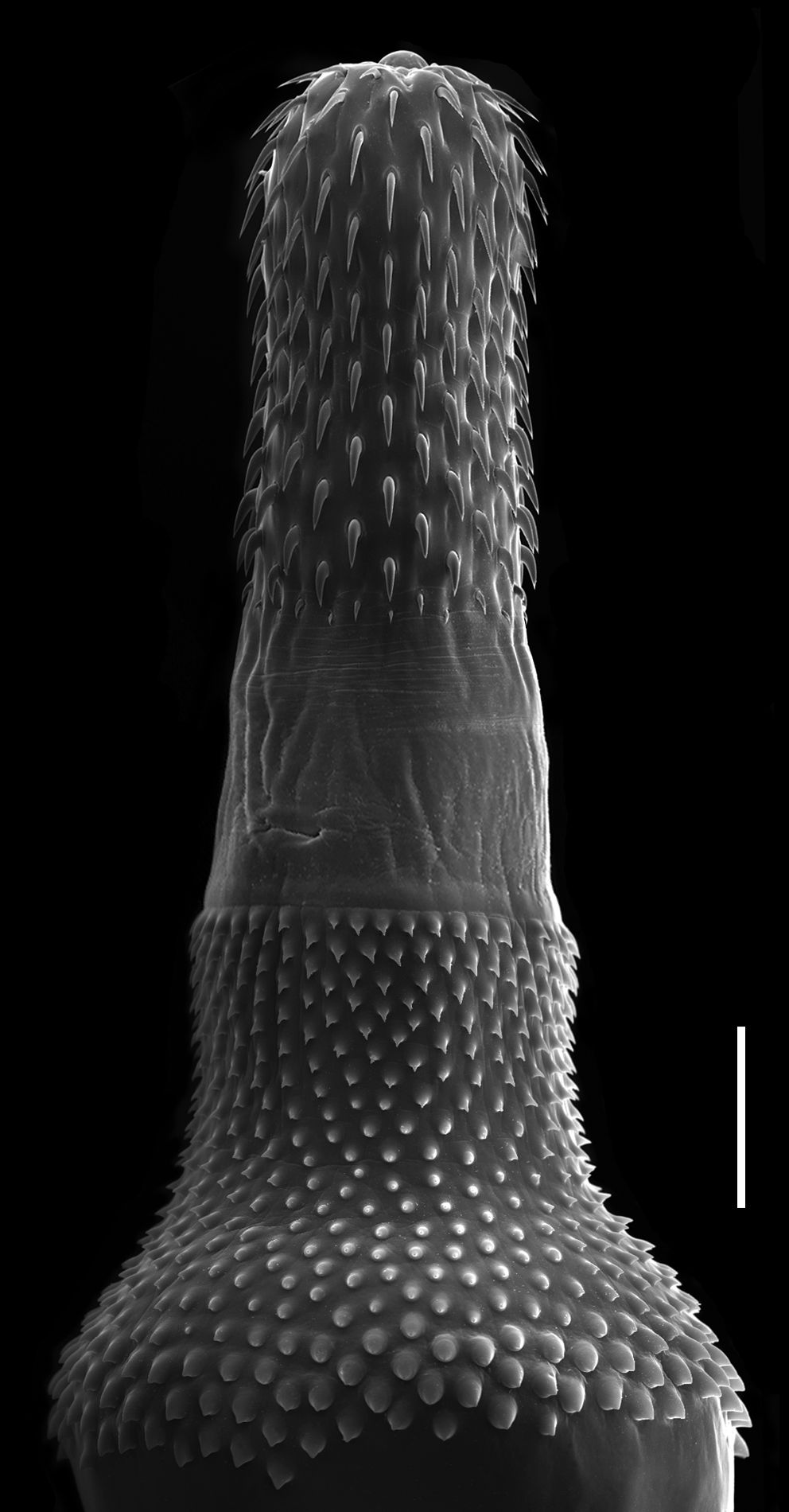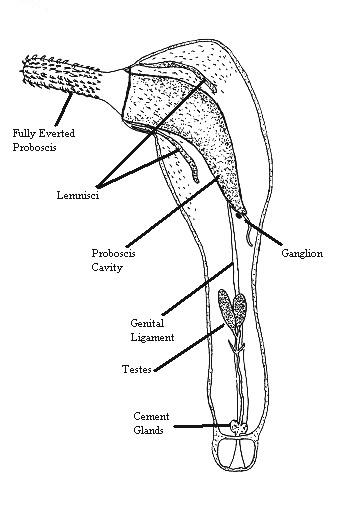|
Neoandracantha Peruensis
''Neoandracantha'' is a genus of parasitic worms from the phylum Acanthocephala. The genus was created in 2017 by Amin & Heckmann for the single species ''Neoandracantha peruensis''. The genus was differentiated from the closely related genus '' Andracantha'' Schmidt, 1975 because members of ''Andracantha'' have anteriorly enlarged pear-shaped ''Corynosoma''-like trunks, only two fields of anterior trunk spines with occasional genital spines, and bilateral or tandem testes, and because proboscides of species of ''Andracantha'' have considerably fewer hooks that gradually decrease in size posteriorly. ''Neoandracantha peruensis'' is an endoparasite in the Polymorphidae family of thorny-headed worms. The larval stages (cystacanths) of ''Neoandracantha peruensis'' were described from the ghost crab ''Ocypode gaudichaudii ''Ocypode gaudichaudii'', also known as the painted ghost crab or cart driver crab, is a species of crab found on Pacific beaches from El Salvador to Chi ... [...More Info...] [...Related Items...] OR: [Wikipedia] [Google] [Baidu] |
Phylum
In biology, a phylum (; plural: phyla) is a level of classification or taxonomic rank below kingdom and above class. Traditionally, in botany the term division has been used instead of phylum, although the International Code of Nomenclature for algae, fungi, and plants accepts the terms as equivalent. Depending on definitions, the animal kingdom Animalia contains about 31 phyla, the plant kingdom Plantae contains about 14 phyla, and the fungus kingdom Fungi contains about 8 phyla. Current research in phylogenetics is uncovering the relationships between phyla, which are contained in larger clades, like Ecdysozoa and Embryophyta. General description The term phylum was coined in 1866 by Ernst Haeckel from the Greek (, "race, stock"), related to (, "tribe, clan"). Haeckel noted that species constantly evolved into new species that seemed to retain few consistent features among themselves and therefore few features that distinguished them as a group ("a self-contained unity" ... [...More Info...] [...Related Items...] OR: [Wikipedia] [Google] [Baidu] |
Andracantha
''Andracantha'' is a genus of parasitic worms belonging to the family Polymorphidae. The species of this genus are found in Northern America. Species: *'' Andracantha baylisi'' *'' Andracantha clavata'' *'' Andracantha gravida'' *'' Andracantha leucocarboi'' *'' Andracantha mergi'' *''Andracantha phalacrocoracis The thorny-headed worm family (biology), family Polymorphidae contains endoparasites which as adults feed mainly in fish and aquatic birds. When this taxon was erected by Meyer in 1931, a subfamily Polymorphinae was established in it. As the Poly ...'' *'' Andracantha sigma'' *'' Andracantha tandemtesticulata'' *'' Andracantha tunitae'' References Polymorphidae Acanthocephala genera {{acanthocephalan-stub ... [...More Info...] [...Related Items...] OR: [Wikipedia] [Google] [Baidu] |
Endoparasitism
Parasitism is a close relationship between species, where one organism, the parasite, lives on or inside another organism, the host, causing it some harm, and is adapted structurally to this way of life. The entomologist E. O. Wilson has characterised parasites as "predators that eat prey in units of less than one". Parasites include single-celled protozoans such as the agents of malaria, sleeping sickness, and amoebic dysentery; animals such as hookworms, lice, mosquitoes, and vampire bats; fungi such as honey fungus and the agents of ringworm; and plants such as mistletoe, dodder, and the broomrapes. There are six major parasitic strategies of exploitation of animal hosts, namely parasitic castration, directly transmitted parasitism (by contact), trophicallytransmitted parasitism (by being eaten), vector-transmitted parasitism, parasitoidism, and micropredation. One major axis of classification concerns invasiveness: an endoparasite lives inside the host's body; an ect ... [...More Info...] [...Related Items...] OR: [Wikipedia] [Google] [Baidu] |
Polymorphidae
The thorny-headed worm family Polymorphidae contains endoparasites which as adults feed mainly in fish and aquatic birds. When this taxon was erected by Meyer in 1931, a subfamily Polymorphinae was established in it. As the Polymorphidae as presently understood would then be monotypic, with no basal genera outside the Polymorphinae, the proposed subfamily is redundant for the time being and therefore most modern treatments simply omit it. '' Polymorphus minutus'' is an economically significant parasite in goose and duck farming. Species Polymorphidae contains the following species: ''Andracantha'' Schmidt, 1975 *''Andracantha baylisi'' (Zdzitowiecki, 1986) Zdzitowiecki, 1989 *''Andracantha clavata'' (Goss, 1940) ''Andracantha gravida'' (Alegret, 1941) Schmidt, 1975 *''Andracantha mergi'' Lundström, 1942 *''Andracantha phalacrocoracis'' (Yamaguti, 1939) *''Andracantha tandemtesticulata'' Monteiro, Amato & Amato, 2006 *''Andracantha tunitae'' (Weiss, 1914) ''Ardeirhynchus'' ... [...More Info...] [...Related Items...] OR: [Wikipedia] [Google] [Baidu] |
Thorny-headed Worm
Acanthocephala (Greek , ', thorn + , ', head) is a phylum of parasitic worms known as acanthocephalans, thorny-headed worms, or spiny-headed worms, characterized by the presence of an eversible proboscis, armed with spines, which it uses to pierce and hold the gut wall of its host. Acanthocephalans have complex life cycles, involving at least two hosts, which may include invertebrates, fish, amphibians, birds, and mammals. About 1420 species have been described. The Acanthocephala were thought to be a discrete phylum. Recent genome analysis has shown that they are descended from, and should be considered as, highly modified rotifers. This unified taxon is known as Syndermata. History The earliest recognisable description of Acanthocephala – a worm with a proboscis armed with hooks – was made by Italian author Francesco Redi (1684).Crompton 1985, p. 27 In 1771, Joseph Koelreuter proposed the name Acanthocephala. Philipp Ludwig Statius Müller independently called the ... [...More Info...] [...Related Items...] OR: [Wikipedia] [Google] [Baidu] |
Ocypode Gaudichaudii
''Ocypode gaudichaudii'', also known as the painted ghost crab or cart driver crab, is a species of crab found on Pacific beaches from El Salvador to Chile as well as on the Galápagos Islands. The species was first described by Henri Milne-Edwards and Hippolyte Lucas in 1843. They are diurnal crustaceans that display a red-orange color with sandy dots across the back of the carapace. They are described with three distinct feeding behaviors that vary based on food source and development: as deposit feeders, scavengers, and predators. In all methods of feeding, visual clues and chemosensory are used to locate potential food. Their diet includes organic matter within sand, live organisms, and dead matter from both ocean and terrestrial sources. In Peru, this crab is the host of the acanthocephalan parasite '' Neoandracantha peruensis''. Taxonomy ''Ocypode gaudichaudii'' was first described in 1843 by Henri Milne-Edwards and Hippolyte Lucas as they voyaged along the coas ... [...More Info...] [...Related Items...] OR: [Wikipedia] [Google] [Baidu] |
Acanthocephala Genera
Acanthocephala (Greek , ', thorn + , ', head) is a phylum of parasitic worms known as acanthocephalans, thorny-headed worms, or spiny-headed worms, characterized by the presence of an eversible proboscis, armed with spines, which it uses to pierce and hold the gut wall of its host. Acanthocephalans have complex life cycles, involving at least two hosts, which may include invertebrates, fish, amphibians, birds, and mammals. About 1420 species have been described. The Acanthocephala were thought to be a discrete phylum. Recent genome analysis has shown that they are descended from, and should be considered as, highly modified rotifers. This unified taxon is known as Syndermata. History The earliest recognisable description of Acanthocephala – a worm with a proboscis armed with hooks – was made by Italian author Francesco Redi (1684).Crompton 1985, p. 27 In 1771, Joseph Koelreuter proposed the name Acanthocephala. Philipp Ludwig Statius Müller independently called the ... [...More Info...] [...Related Items...] OR: [Wikipedia] [Google] [Baidu] |


